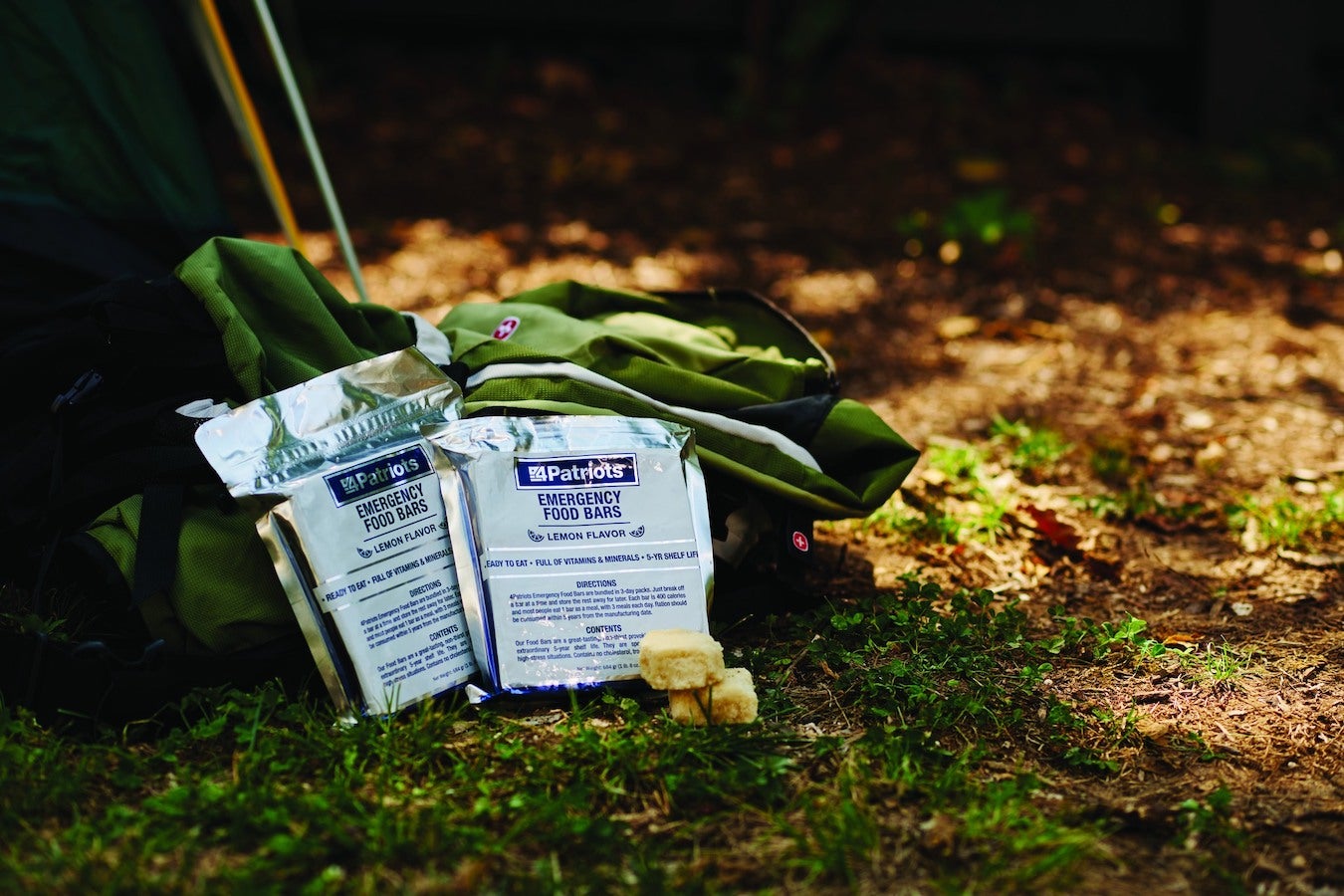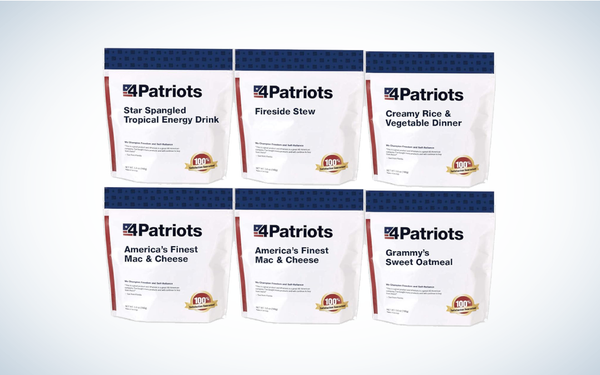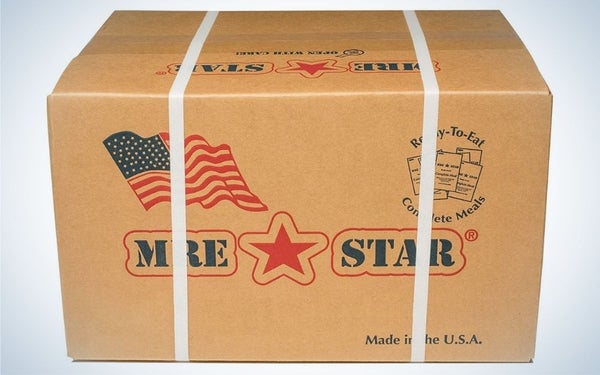| Best Overall |
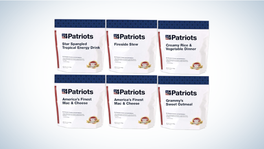
|
4Patriots Survival Food Kit | SEE IT |
LEARN MORE
|
Summary
Designed by chefs and nutritionists, these American-made meals can stay fresh for up to 25 years—perfect for emergency prep. |
| Best Short-Term |
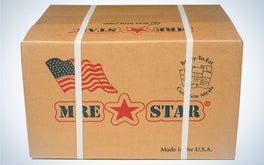
|
MRE | SEE IT |
LEARN MORE
|
Summary
Military-style rations are popular with the disaster readiness crowd because they are simple and easy. Just open the pouch and you’re ready to eat. |
| Best Food Kits |
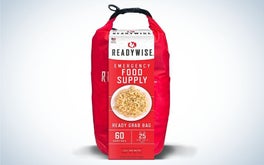
|
ReadyWise Food Supply Emergency Grab Bag | SEE IT |
LEARN MORE
|
Summary
With a good variety in an easy-to-transport dry sack, this is the best survival food kit that will keep you fed for several days without getting bored of eating the same thing over and over. |
There is a dizzying array of options when it comes to the best survival food and it is easy to quickly become overwhelmed. Not all that long ago, shopping for these products was mostly limited to those planning extended hiking and camping trips. However, events of the last couple of years have convinced many people of the need to have a good stockpile of necessities on hand, just in case.
No matter where we are or what crisis befalls us, we all need food. Calories are the fuel that runs our bodies. While conventional wisdom dictates that we can survive several weeks without eating, as a practical matter few people would relish testing their limits by doing so. Fortunately, as the popularity of survival food has increased, so has the number of high-quality offerings being produced.
- Best Overall: 4Patriots Survivial Food Kit
- Best Short-Term: MRE
- Best Long-Term: Mountain House Adventure Meals
- Best Food Bars: Datrex 3600 Emergency Food Bar
- Best Food Kits: ReadyWise Food Supply Emergency Grab Bag
How We Picked the Best Survival Food
As something of an authority on disaster readiness and survival planning, one of the key product categories I research heavily is food, particularly products that are specifically made and packaged for long-term storage. I’ve personally tested numerous varieties of food products and selected items for this guide based on my experiences with them.
What I look for in survival food is primarily a combination of taste and value. It makes little sense to spend a lot of money buying food you don’t like. Other key factors that went into my recommendations include:
- Shelf stability: Hopefully, you won’t be eating these meals on a regular basis. As such, they need to be able to be stored for long periods of time without going bad. The products I choose will last until they are needed.
- Calorie count: You need a certain number of calories to get through the day. I selected meals that provided enough energy to get through stressful situations.
- Nutritional value: Nutrition goes beyond calories. While nothing can replace fresh vegetables, I chose meals that provide a good mix of the vitamins and minerals your body needs. I also eliminated those that were high in sodium or other potentially harmful substances.
The Best Survival Food: Reviews & Recommendations
Best Overall: 4Patriots Survival Food Kit
Specs
- Shelf Life: 25 years
Pros
- Quick and easy to make
- Mylar packaging keeps food fresh for longer
- Made in the USA by nutritionists and chefs
Cons
- More expensive
4Patriots is arguably one of the most popular—if not the most popular—survival food brands out there. All of its products are manufactured and packaged in the United States, so you can feel good about supporting an American business. The meals are designed by nutritionists and chefs for both optimal nutritional value and optimal flavor. Free of MSG, they’re made with fresh ingredients and whole grains. Even better, they’re easy to prepare—just boil water, add the pouch, and you’ll have a hot meal in 15 minutes. Speaking of pouches, 4Patriots survival food comes in triple-layer Mylar packaging to extend the shelf life by keeping out air and moisture.
You can choose from a bunch of different kit sizes based on how long you need food for, whether you just want 72 hours worth of meals all the way up to one year. Each kit provides enough food for one person to have six servings a day, with enough calories and nutrients to keep you functioning. Plus, you get a large variety of meal options, including macaroni and cheese, harvest vegetable soup, and sweet oatmeal. No matter which package you choose, 4Patriots is perfect for survival kits and emergency preparedness.
Best Short-Term: MRE
Specs
- Shelf Life: 3 to 5 years
Pros
- Full ready-to-eat meal in every pouch
- Easy to store and use
- Calorie dense food
- Can be eaten hot or cold
Cons
- Can cause digestive upset with some people
The appeal of MREs (Meals, Ready to Eat) is that they offer a complete package. In a single pouch, you’ll find:
· Main entrée
· Starch (crackers, tortilla, or other)
· Snack (corn nuts, nut and raisin mix, dry fruit mix, or other)
· Dessert (cookies or other)
· Drink mix (fruit flavored)
· Utensils
· Napkin
· Wet nap
· Coffee
· Sugar
· Salt
· Pepper
· Hot sauce
· Candy
Plus, a heater that, once activated, will warm your entrée, giving you a hot meal on the go. Each MRE pouch has literally everything you’ll need to stay fed making them our choice for the best short-term survival food.
Now, there are a couple of drawbacks to this convenience. Some users report digestive upset, specifically constipation, after consuming MREs, especially if doing so over a period of time. Also, the pouches are bulky and somewhat heavy for their size, so they aren’t ideal for transporting on foot. However, you’re not likely to find another type of survival food that packs this much stuff into a single package.
These meals will store for upwards of five years in cool conditions. They recommend a storage temperature of under 70°F.
Best Long-Term: Mountain House Adventure Meals
Specs
- Shelf Life: 30 years
Pros
- 30-year taste guarantee
- Simple to prepare
- Hot meals almost anywhere
- No artificial colors or flavors
- Over two dozen varieties to choose from
Cons
- Some varieties are high in sodium
Being able to provide a hot meal to your family, no matter what sort of disaster strikes isn’t just a point of pride. Doing so can improve mood and reduce anxiety about the situation. It brings a degree of familiarity in the chaos of a disaster. These Mountain House meals taste great and you only need boiling water to prepare them.
What’s really nice is that you rehydrate the food in the pouch and you can eat it right from there, so there’s very minimal cleanup after everyone is done with the meal. And with almost 30 different varieties, including breakfasts and desserts, nobody is going to complain that the food is boring.
There’s an average of about 250 calories per serving, depending on the meal variety. Each pouch has two servings, so there’s plenty for a hearty eater if there’s no need to split the pouch between family members.
Given that these meals are designed to be just as fresh in 30 years as they are now, you’ll be eating well for decades to come.
Best Bars: Datrex 3600 Emergency Food Bar
Specs
- Shelf Life: 5 years
Pros:
- Lots of calories for not much money
- Non-GMO and no nuts
- Approved by the U.S. Coast Guard
Cons:
- Not suitable for long-term regular use
Datrex emergency rations have been around for a long time, and for good reason. They pack a ton of calories into a small package, plus they aren’t bad tasting making them the best survival food bars. For many years, these sorts of emergency food bars have been a staple on lifeboats. The reason for that is they provide calories and energy without provoking thirst, which is important if your supply of potable water is severely limited.
These rations are low in sodium, which is a striking contrast to many other survival foods on the market today. They are easy to digest, which is always a plus. The bars have a nice coconut cookie sort of taste. They are fairly dry and easy to crumble as they’re removed from the package.
The bars contain both coconut and wheat, thus users with allergies to either should avoid them. The directions indicate you should eat one bar every four hours (every six hours if you’re at sea). One package should last a person three days. However, this isn’t exactly a balanced diet and it isn’t recommended to rely solely on these bars for several days or weeks on end.
Best Kits: ReadyWise Food Supply Emergency Grab Bag
Specs
- Shelf Life: Up to 25 years
Pros:
- A total of 60 servings in a compact size
- 16 of the servings are gluten-free
- Options for breakfast, lunch, and dinner
- Easy to prepare
Cons:
- Requires a reliable source of clean water
Appetite fatigue is what can happen when you’re forced to eat the same foods over and over, every single day. After a while, your body just doesn’t want it anymore, no matter how hungry you might be. That can be avoided with this survival food kit from ReadyWise. It has 60 total servings spread between seven different meal options.
Each meal requires nothing more than the addition of boiling water. You simply pour the required amount of water into the food pouch, then close it up. Wait a few minutes and you’re ready to dig in.
The varieties included in this kit are:
· Brown Sugar and Maple Multi-Grain Cereal
· Crunchy Granola
· Cheesy Macaroni
· Creamy Pasta and Vegetables
· Potatoes and Chicken Pot Pie (gluten-free)
· Teriyaki Rice (gluten-free)
· Savory Stroganoff
With this many servings, you can feed an average family for several days. Plus, the bag itself is easy to grab and take with you, should you need to evacuate in a hurry. Just make sure you grab a case of bottled water as well, to ensure you’ll have it to rehydrate the meals for consumption. All in all, this is an excellent option for anyone’s disaster plan.
What to Consider When Choosing Survival Food
One of the first considerations, and one that far too many people overlook, is whether you like the food. How does it taste? What about texture? Does it agree with you? It is easy to concentrate on just amassing a large quantity of survival food. But the reality is that if you don’t like the food, you’re just throwing good money away. There are those who will say that when you get hungry enough, you’ll eat almost anything. While true, you’re not in that position right now. You have the luxury to invest in food products you’ll actually want to eat.
The other primary consideration is cost. Most of us aren’t independently wealthy and thus we need to carefully think through any major purchase. A solid approach that works for many people is to buy a little at a time as the funds are available and let the supply at home build over time. This makes a large expense a little easier to manage.
Of course, there’s also the available storage space to bear in mind. If you live in an apartment, condo, or small home, you probably don’t have endless storage available to you. Therefore, finding room for the food you buy can be difficult. As a result, pay attention to the package size and the number of servings per product, and get the biggest bang for your limited shelf space as possible.
FAQs
Q: How do you store survival food?
Storing survival food is best done in conditions that are dark, cool, and dry. These three factors will work together to slow down the degradation of the food. A closet in a spare bedroom, for example, might be a great location. A damp basement, perhaps not so much.
Q: How much food do you need?
The amount of survival food you should store will largely depend on how many mouths you’re feeding and for how long you’ll be reliant upon your survival food. I recommend stocking up in stages. Your first goal is to have enough food on hand to keep your family fed for two full weeks. Once you reach that stage, keep at it until you have enough for a month. From there, it really depends on personal preference how much further you go with storing survival food.
Q: What else do you need in a survival situation?
Your needs in a survival situation go well beyond just food, of course. Water is higher on the list than calories, if we’re being honest. You won’t last more than a few days without some means of hydration. Along with water and food, you’ll need ways to maintain your core body temperature. For winter months, this might include extra blankets and such, in case the power goes out for a long period of time. In the summer, look for ways you’ll be able to cool down if air conditioning isn’t available at home. And having the best flashlight or two on hand is always a good idea.
Best Survival Food: Final Thoughts
- Best Overall: 4Patriots Survivial Food Kit
- Best Short-Term: MRE
- Best Long-Term: Mountain House Adventure Meals
- Best Food Bars: Datrex 3600 Emergency Food Bar
- Best Food Kits: ReadyWise Food Supply Emergency Grab Bag
Choosing survival food to keep on hand for emergencies requires a little homework and research. You shouldn’t buy several cases of something simply because the package looks enticing. Base your decision on facts, including budget and the quality of the food. Ease of preparation is also a factor, of course. In an emergency, you may not have ready access to things like stovetops or microwave ovens. Stick with things that require a minimal amount of preparation. Hopefully, you’ll never be in a situation where you must rely on survival food, but you’ll be glad you have it should the unthinkable occur.
Why Trust Us
For more than 125 years, Field & Stream has been providing readers with honest and authentic coverage of outdoor gear. Our writers and editors eat, sleep, and breathe the outdoors, and that passion comes through in our product reviews. You can count on F&S to keep you up to date on the best new gear. And when we write about a product—whether it’s a bass lure or a backpack—we cover the good and the bad, so you know exactly what to expect before you decide to make a purchase.
